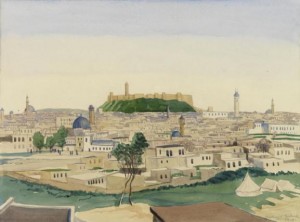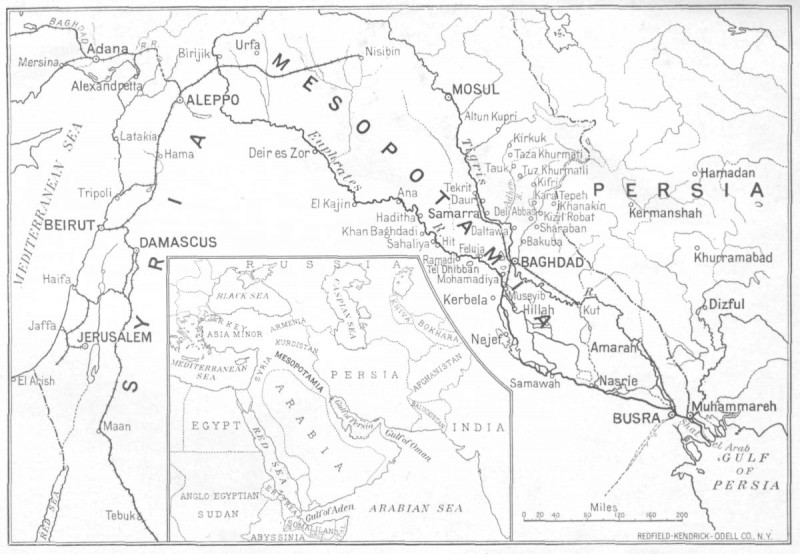Shared Sorrows: Indians and Armenians in the prison camps of Ras al-‘Ain, 1916-18 – 8.
On September 7 1916, one hundred of the Indian prisoners who had marched to Ras al-‘Ain with Sisir Sarbadhikari started working on an Ottoman rail line .
[This picture is from the Imperial War Museum (via the First World War Poetry Digital Archive & the Ottoman History Podcast). It is tagged as ‘Indian Engineers in Mesopotamia’ with no other details. I remember seeing, on the Net, a similar picture of Indian POWs working on the Ottoman railway line north of Ras al-‘Ain: unfortunately I haven’t been able to find it again. A link would be much appreciated.]
Sisir Sarbadhikari and his fellow paramedics from the Bengal Ambulance Corps worked in the camp hospital and did not have to go out to the rail line. A few weeks after their arrival in camp, the Turkish guards turned the officers’ quarters upside down, during a search. It was now that Sisir buried his diary, fearing that it would be found. He did not dig it up again until the trouble stopped. (p. 140)
Over the next few weeks the camp’s medical facilities were expanded. New doctors arrived, among them some Armenians. The relations between the Indian medical staff and the Armenian doctors were not always easy.
‘One day,’ writes Sisir, ‘the hospital’s Armenian doctor swore at Champati [an Indian NCO] and had Sundar Singh [an Indian paramedic] thrown behind bars. The reason was that an Armenian prisoner from Russia complained about the hospital being staffed by Indians; he said they gave the Indian patients better food. Being an Armenian himself the doctor created an incident without inquiring further. On informing Captain Puri, Sundar Singh was let off. There was always friction between us and the Russian prisoners. After this it got worse.’ p. (141)
In November typhus broke out in the Indian camp. An epidemic of the disease had already ravaged many of the Armenian camps in the Ras al-‘Ain area.

It now began to take a serious toll on the Indian prisoners. Several members of the Bengal Ambulance Corps went down with it, among them Sisir’s friend Bhola – the 16-year-old who had exaggerated his age to get into the corps.

Sisir himself escaped this outbreak of the disease. He was occupied in tending to the stricken when it was decided that he would take the most serious patients to Aleppo (Halbe).[i]
Sisir was reluctant to go because he did not wish to be separated from his friends. He did not know it of course, but the order that sent him away from Ras al-‘Ain was a blessing in disguise. The coming winter would decimate the prisoners who remained in Ras al-‘Ain. Many would die of disease, exhaustion, and the cold. Had Sisir not been sent to Aleppo at this time, he may well have been among the casualties. Later, he would write: ‘That was our first winter in Turkey and we had no clothes to speak of; many didn’t have boots… [The prisoners] would be taken to work barefoot on the line, in the snow. They would get frostbite at first and then the flesh would fall off and the wounds would turn gangrenous’ (p. 167-8). [ii]
E.A.Walker, a British officer, estimated that 75 per cent of the Indian prisoners died in that first year. [iii]

[i] Sisir generally uses the Arabic words Halbe or Halab for Alleppo.
[ii] Santanu Das writes: ‘according to a British eye-witness account, [the Hindu prisoners were like] ‘animated skeletons hung about with filthy rags’.’ Cf. Indians at home, Mesopotamia and France, 1914-1918: towards an intimate history, in Das, Santanu (ed.): Race, Empire and First World War Writing, CUP, 2011.
[iii] ( IWM 76/115/1 Diary of E.A.Walker, 17/7/16), quoted in Heather Jones, Imperial Captivities: Colonial Prisoners of War in Germany and the Ottoman Empire, 1914-1918, in Das, Santanu (ed.): Race, Empire and First World War Writing, CUP, 2011.


Does anybody have Sisir Sarbadhikari’s picture?